In Aviation Statistics I described how I became a student pilot. But once started, the journey was nothing like I ever expected. Learning to be a pilot was as much academic study as it was practical skills. At the University of Illinois, this meant a three-hour lecture course combined with semi-weekly “lab” sessions at the airport.
Heading for the airport the first time, I felt like a five-year-old on my first day of kindergarten. I could hardly wait to get behind the controls. My CFI (Certified Flight Instructor) was Maurice Hovious. I was his first student … ever! We chatted, then he said, “Let’s get started.” But we didn’t head out to the airplanes! We never even saw an airplane.
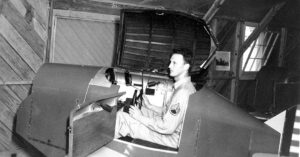
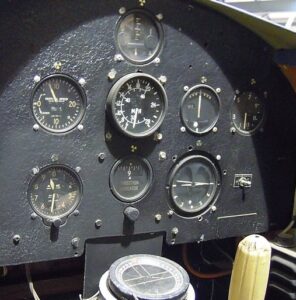
The closest I came that first day was a Link Trainer – a large odd-looking movable box on a pedestal with a bench for me to sit on, a stick, a “throttle” and a few weird dials. At Maurice’s direction, I climbed into the box and he closed it up. Blackness. Nothingness. Is this what I signed up for?! He turned it on and talked to me through an intercom. I wiggled the controls; the dials and the box danced around. Finally I climbed out of the box having no idea what I had just done.
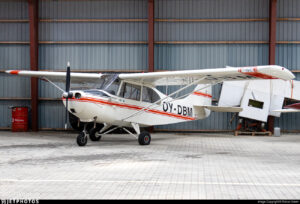
My next lesson differed from the first only to the extent that there was less talk and more time in the box. Finally, on the third lesson I saw a real airplane. Covering all the windows were sheets of clear orange plastic. Then Maurice handed me a pair of blue goggles. In case you’ve never tried it, if you filter out all the blue light and all the orange light, what you see is nothing. Nothing but the same weird dials I saw in the box. Flight instruments.
In the third week, the blinders were removed. I excitedly anticipated flying twice a week. Actually, flying twice a week, weather permitting. I thought that meant if it was not cloudy. Weather permitting for students also meant almost no wind. Champaign, Illinois is on the open prairie – it’s always windy. I learned to look at the trees on the way to the airport. If the tops were moving, it was too windy to fly. It would either be ground school, which is listening to the instructor, or flying the box again. Nonetheless, we were flying, I was learning to fly.
First solo –
There are three thresholds in attaining a private pilot license. The first and biggest thrill is flying solo. (In later years, as an instructor, at some point in a student’s very first flight, I told him or her, “You’re training to be a pilot in command. Look around you. Now picture yourself without the instructor sitting next to you. Who are you going to turn to for help? You’re the one in charge. The pilot in command. The captain. You may be able to reach someone on the radio, but it’s still you flying the airplane.) My lessons progressed and after about five weeks we began practicing landing. Some planes are designed for training – they can take a licking and keep on ticking. And I gave ours quite a licking. I must have scared Maurice one day, because he had me pull off the runway and let him out. “Go back and make three touch-and-goes by yourself. Good ones.”
I soloed!
Flying solo provided a great opportunity to perfect essential flight maneuvers. However, while all this was going on, I had just become engaged. Solo flight became a great opportunity to survey the surrounding area and find perfect abandoned roads where my fiancé and I could make out at night. Needless to say, my flying skills suffered.
Cross Country Flight –
The second big threshold is cross country flight. Flights have to be planned in detail including the route and checkpoints, weather, airport requirements, fuel needed for the flight and alternatives in case things didn’t go as planned. It felt like more time was spent planning than flying. At the University of Illinois cross country training was done with other students, each flying part of the trip. And doing it in four-seaters like a Cessna 172 or a Piper Tri-Pacer. Suddenly I was climbing into an airplane that felt twice as big as the two-seater I had been flying. And for the first time, I had passengers.
One of the cross countries involved a trip at night. Flying into a major city – in my case St. Louis – was an eye-popping experience. I love flying at night. The spectacular light displays of both cities and airports thrill me still.
Check Ride –
The final threshold is the check ride – an interesting experience for which I felt wholly unprepared. This time riding with me was not a instructor but a pilot examiner. In this case, he was also the chief pilot and a man who was legendary at the university, Omer Benn. First he quizzed me on aeronautical knowledge and the flight plan I had prepared. That went fine.
But when we got into the airplane, my failure to practice while flying solo flight reared its ugly head. After miserable attempts to do the required maneuvers, Omer said, “I’ll take the controls.” I knew I was going to flunk.
But then he went on to say, “I think every pilot should know what the inside of a cloud looks like.” So into a cloud he flew. Being inside a cloud is like swimming in milk. There’s no up or down or any other reference that one can sense. Omer twisted and turned. Then he flew out of the cloud, gave the controls back to me, and told me to go back to the airport.
I had no clue where he had taken me. And in central Illinois, one field looks pretty much like every other. I asked if I could use the radio. He said I could use anything in the airplane. So I tuned in the beacon (VOR) at Champaign and discovered that the airport was east of us. Unbeknownst to me, while in the clouds, Omer had scrambled (tumbled) the gyro compass. Aha, I recognized the trick right away! I reset the gyro aligning it with one of the roads that were all east/west or north/south, and headed back to the airport. But I wasn’t getting closer. In fact, I was rapidly heading off course. In a lucid moment, I realized I was heading south – not east. I fixed the error and took us home.
When we returned to the flight office, Omer told me that my flying skills needed work and I should keep that in mind. But he was impressed with my judgment in figuring out and remedying a problem and so he gave me my private pilot license.
I was a pilot!
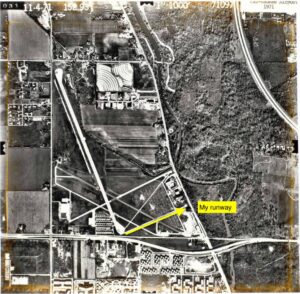
The first stop on summer break was Palwaukee Airport. Back in 1962, It was a pretty simple airport. Five runways. No fences. No control tower. Business jets didn’t yet exist. And a flight school where I learned just how right Omer was about my flying skills.
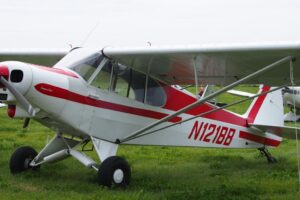
Checking out in a Piper Super Cub, I had to land right past what looked to me like the Empire State building. After clearing that I had to immediately get the wheels down on the near end of the runway because the trees at far end of the runway were frightfully close. After 3½ hours of additional training, the instructor was satisfied I wouldn’t wreck his airplane. I never actually wet my pants, but I’ll never forget the look of those trees as they came at me. By the way, only a few years later that they closed that runway because it was to short.
At the end of the summer, Lynn and I began our new married life as flat broke students. On my meager earnings stocking shelves at a grocery store, flying was pushed to the back burner. For our first Christmas together, I thought of a wonderful gift. I saved every penny, nickel and dime I could find and bought her a savings bond.
She on the other hand bought me an hour of flying. Hmmm … maybe I needed a course in marriage!
New Ratings: Private Pilot – Airplane Single Engine Land (ASEL)
New Types: Link Trainer, Aeronca 7FC TriChamp, Piper TriPacer, Cessna 172, Piper Super Cub
